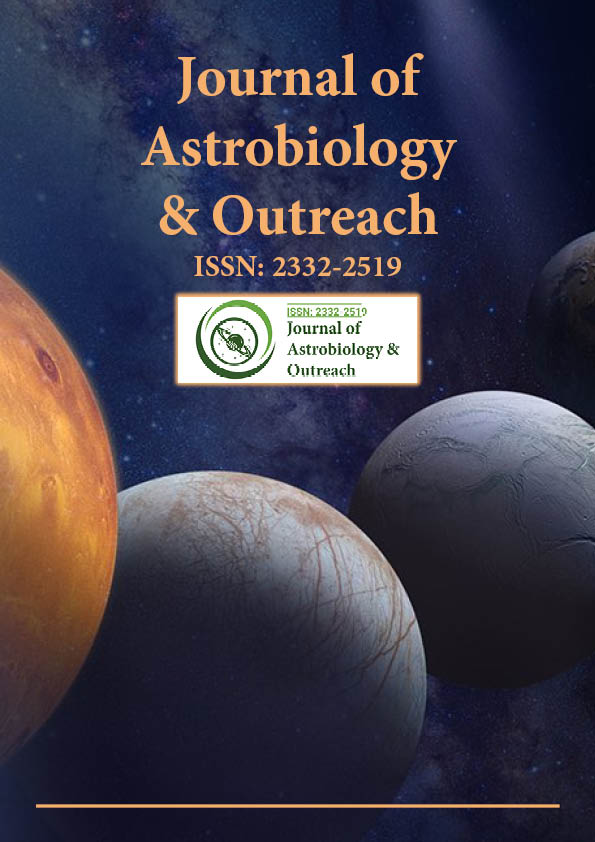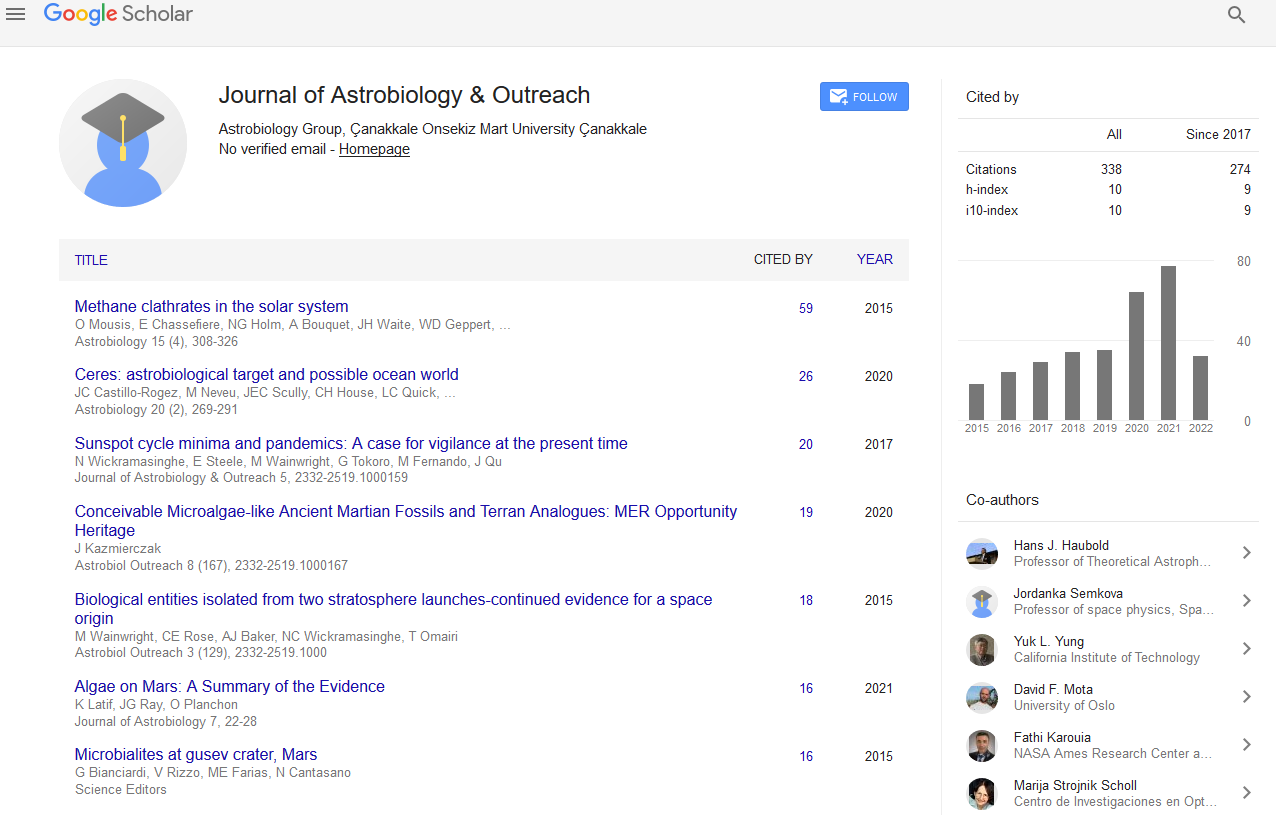Indexed In
- Open J Gate
- Academic Keys
- JournalTOCs
- RefSeek
- Hamdard University
- EBSCO A-Z
- OCLC- WorldCat
- Google Scholar
Useful Links
Share This Page
Journal Flyer

Open Access Journals
- Agri and Aquaculture
- Biochemistry
- Bioinformatics & Systems Biology
- Business & Management
- Chemistry
- Clinical Sciences
- Engineering
- Food & Nutrition
- General Science
- Genetics & Molecular Biology
- Immunology & Microbiology
- Medical Sciences
- Neuroscience & Psychology
- Nursing & Health Care
- Pharmaceutical Sciences
Perspective - (2024) Volume 12, Issue 3
The Quantum Leap in Radio Astronomy: Advancing Calibration Efficiency and Precision
Sophia Delgado*Received: 30-Aug-2024, Manuscript No. JAO-24-27916; Editor assigned: 02-Sep-2024, Pre QC No. JAO-24-27916 (PQ); Reviewed: 16-Sep-2024, QC No. JAO-24-27916; Revised: 23-Sep-2024, Manuscript No. JAO-24-27916 (R); Published: 30-Sep-2024, DOI: 10.35248/2332-2519.24.12.357
Description
Quantum radio astronomy represents an innovative frontier in the search to decode the mysteries of the universe. It merges the principles of quantum computing with the challenges of radio interferometry, providing innovative approaches to process the massive datasets generated by modern radio telescopes. Among these approaches, the application of quantum linear solvers for redundant baseline calibration has proven to be a transformative tool, potential to revolutionize the efficiency and accuracy of data calibration in radio astronomy.
In radio interferometry, redundant baseline calibration is a critical process for extracting meaningful information from the signals captured by an array of telescopes. These telescopes operate by measuring the interference patterns of incoming radio waves, generating vast amounts of data across numerous baselines (the vector distances between pairs of telescopes). In redundant baseline calibration, the assumption is that multiple baselines of the same length and orientation should produce identical measurements, allowing systematic errors to be identified and corrected. However, as the number of telescopes and baselines increases, the calibration problem becomes a computationally intensive task, often requiring the inversion of large matrices and iterative processing.
The combination of quantum solvers into radio astronomy workflows is particularly promising for next-generation telescopes, such as the Square Kilometre Array (SKA). These arrays are designed to observe the universe at unmatched sensitivity and resolution, generating petabytes of data daily. Traditional calibration methods struggle to keep pace with such data volumes, often requiring vast computational resources and extended processing times. Quantum solvers, on the other hand, have the potential to reduce these bottlenecks, enabling real-time or near-real-time calibration even for the most complex datasets.
Beyond computational efficiency, quantum solvers also hold the potential of improved calibration accuracy. By utilizing the quantum properties of superposition and entanglement, these solvers can explore the solution space more comprehensively than classical algorithms, potentially identifying optimal solutions with higher precision. This improved accuracy is essential for radio astronomy, where subtle errors in calibration can obscure faint signals or introduce artifacts that compromise scientific analyses.
The broader implications of quantum radio astronomy extend beyond data calibration. The successful implementation of quantum solvers in repetitive baseline calibration serves as a proof of concept for applying quantum computing to other computationally intensive problems in astronomy, such as imaging reconstruction, spectral deconvolution and pulsar signal analysis. These advancements could transform the way astronomers analyze and interpret the cosmos, creating the path for new scientific insights and discoveries.
The synergy between quantum computing and radio astronomy also has significant implications for outreach and education. The concept of quantum computers aiding in the exploration of the universe captures the imagination, providing a compelling narrative to engage the public and inspire the next generation of scientists. Outreach programs that highlight the intersection of quantum physics and astronomy can demystify complex concepts and showcase the interdisciplinary nature of modern science.
However, realizing the full potential of quantum linear solvers in radio astronomy requires overcoming significant challenges. Quantum computers are still in their early stages of development, with current hardware limited by qubit count, coherence time and error rates. These limitations constrain the size and complexity of problems that can be handled effectively. Furthermore, adapting quantum algorithms to astronomical applications demands collaboration between quantum physicists, computer scientists and astronomers, promoting an interdisciplinary approach that integrates domain-specific expertise.
Despite these hurdles, the trajectory of quantum computing suggests a potential future. Advances in quantum error correction, qubit scalability and hybrid quantum-classical algorithms are steadily expanding the capabilities of quantum hardware. As these technology increases, the combination of quantum solvers into radio astronomy workflows is likely to become more feasible and impactful.
In conclusion, quantum linear solvers for redundant baseline calibration represent an innovative application of quantum computing in radio astronomy, addressing fundamental challenges posed by the data-intensive nature of modern telescopes. By improving the efficiency and accuracy of calibration processes, these solvers create the path for more precise observations and deeper insights into the universe. Beyond their technical contributions, they show the transformative potential of interdisciplinary collaboration, bringing together the fields of quantum computing and astronomy in a shared search to understand the cosmos.
Citation: Delgado S (2024). The Quantum Leap in Radio Astronomy: Advancing Calibration Efficiency and Precision. J Astrobiol Outreach. 12:357.
Copyright: © 2024 Delgado S. This is an open-access article distributed under the terms of the Creative Commons Attribution License, which permits unrestricted use, distribution, and reproduction in any medium, provided the original author and source are credited.

